“The thing to do now, Stanley thought to himself, is to wait. Nothing will hurt me. Nothing will break me. In here, I can be happy, forever. I will be happy.”
(also, spoiler warning)
The year is 2013. I’m a young kid, in my second year of high school. There’s roughly another 5 years left until I leave this place and go on to do bigger things with my life. But in the meantime, to pass the hours between the school life and the dream life, I have my PC. The evening machine, if you will. To whittle away the hours. And what better way to whittle away the hours than playing walking simulators.
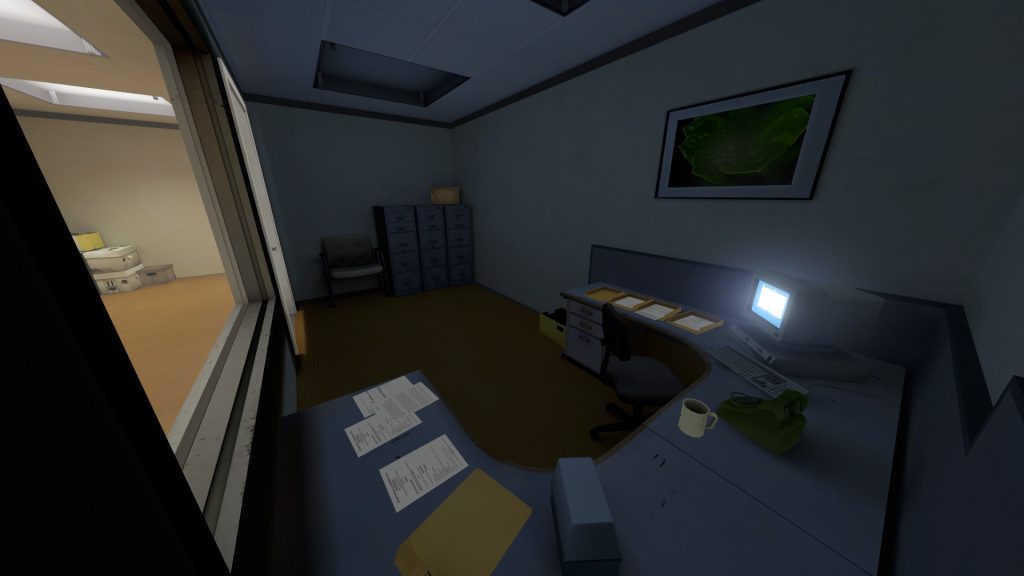
I was 12 when I first played The Stanley Parable. It holds a special place in my formative video game life. It was the first game I played that was willing to seriously challenge what I thought a game was supposed to be.
It was a game that provided such a minimal level of clear overall engagement compared to some of the other titles stashed away in my Steam library, but I ended up playing it for hours on end.
Then more hours. And more. Having known full well there was basically no content left for me to explore, I kept on searching anyway.
I even made a little Steam guide to showcase some of my ‘unique’ findings. “Hello peeps!”, my little guide cried. “Today I will announce my findings inside The Stanley Parable!”.
“Whilst creating this guide, I thought up of another one you guys could help me with, the mystery of 8. Why the heck is 8 repeated all the time? Where can we find 8? What is up with 8? 8888888.” I don’t think I really understood the point of this game as a child.
But alas, as we all do, I grew up. I moved on from Stanley and his Parable. Not before trying to get the “Commitment” achievement, of course. I didn’t manage it, although I was sure I had left my PC on for long enough.
No matter. There were bigger things out there for me, new games to try, new fish for me to fry, new people to meet – and yet, in the blink of an eye, here we are.
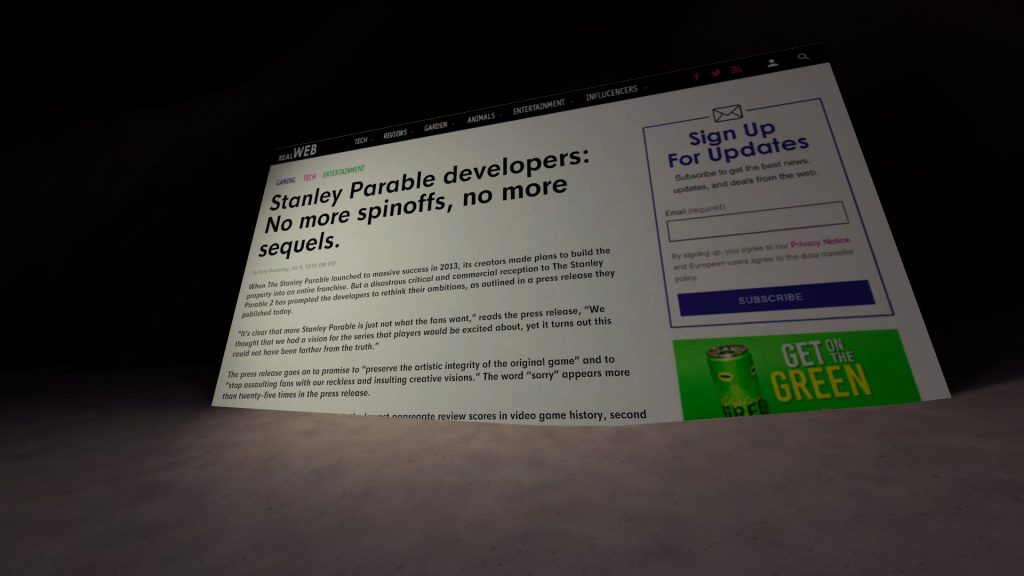
I’m 20 now. About to turn 21, sadly. I feel old. I long for my youthful days, where I had no worries aside from the homework I had due the next day and the onslaught of critics who repeatedly slammed my Steam guide. It was a simpler time.
Nowadays, it feels like my life is fraught with anxiety. I go from place to place, person to person, trying to do so much, to please so many people! I have responsibilities now! It’s awful!
Take me back to the simpler time, to the time when my life was wholesome and free! Back to when Stanley and I were best buddies, roaming around the corridors and sniffing for all sorts of content all over the walls…
Well, they listened. And to be fair, they took their time with it. I think I was 18 (or 17?) when I first heard about the new game in development, and I was pretty pumped.

But then it sort of…went under the radar for a little while? Just fell off the side of the earth, really. I didn’t hear a thing about it until the other month – maybe, January this year? I had gone from being in my last year of that same school to having nearly finished my degree during that time period.
I’m probably still working on my dissertation if you’re watching (or reading) this in May. Actually, I should be working on my dissertation right now. But no, the inconsiderate people at Crows Crows Crows just had to release this a few weeks before my deadline. Well, priorities, I guess.
So, let’s cut to the chase and get to the meat of this. You’ve met me. You’ve seen how important this game was to me at a young age. I’ve got big nostalgia goggles for it. Like, I probably own one of the biggest pairs around.
I got Ultra Deluxe hot off the presses, I was one of the very first loyal customers, and I played it all the way through as soon as I could to see all the brilliant new content. So, what did I think overall? What’s my Metacritic score? Did it add an indispensable and awe-inspiring experience to the original title? How good was it?
Meh.
Seriously, that’s my overall reaction to having essentially “beaten” this game and doing basically everything new it has to offer. The new content was good, but I can’t help feeling underwhelmed by the size of this whole thing.
I don’t think I’m the only person to feel this way either. There are plenty of conflicted reviewers on Steam just like myself, thoroughly enjoying the original, but not seeing this new one as living up to standard. I think this Steam review by “Null” puts it best:
“I think a major point of disappointment for me is the fact that, while the game does have quite a few new ENDINGS, it has very few new PATHS. I counted I think 4 new paths (one of which I’m not sure if it’s bugged or supposed to be so… nonexistent), everything else is reusing the existing paths, all centered around the gag of ‘the same thing, BUT NOW WITH THE BUCKET!!!'”

Have you ever heard the phrase “it’s about the journey, not the destination?”. Well, I don’t believe that anyone at Crows has heard this before. They have, more or less, taken all the existing destinations, multiplied them by two, and tweaked some dialogue on the way.
Aside from this, maybe a few short new journeys have been added? But essentially, there’s not enough here. There’s not enough for me to experience. They’re not embracing the niche nature of walking sims; they haven’t given me many new places to walk.
Now, don’t get me wrong. Other reviews are more scathing of the quality of the “new content” than I am willing to be. The bucket was repetitive, yes, but the new endings with it were genuinely entertaining. The bucket game was a personal highlight, as was the bucket going into space.
And sure, the museum self reflection gag is a little overplayed, but the narrator’s ego wasn’t ever so involved as it is now, and I think that adds an interesting dynamic to the new game. The real problem I have is with the lack of “new paths”, as Null so eloquently puts it.
To structure the rest of this review, and to emphasise the mixed-ness of it, I’m going to separate it into two portions: Pros and Cons. It’s a tradition you can’t really go wrong with, pros and cons. Easy to understand, and it structures my criticism quite well. There’s a lot to talk about, so I’ll just get into it.

What are the “pros”?
The New Writing is True to the Original
The Stanley Parable, at it’s core, is a meta-criticism on game design. It always was. It takes clichés and shoves them in your face – or shoves them completely out of the window – all too ready to shun the bizarre norms of modern titles.
Meanwhile, it has the capacity to tell all sorts of different stories with different levels of intensity and capability. It’s able to laugh at itself, but also carry some meaning – and sometimes, it even decides to be quite mean. There’s lots of different emotions it’s able to bring out of the player, and there’s lots of different journeys it’s able to take us on.
And all of this is still here, but it’s extended on in quite a smart, if slightly overt manner. This time the new theme is twofold: critical reception (and the adequate response to it), then flowing from that, a condition called “sequelitis”.
It’s like the game almost takes you on the existential journey the developers might have actually felt. This is a great extension on the original core theme, and the comedic direction here is pretty much flawless.
I think the ‘character’ that best demonstrates this is “Cookie9”, who initially left a negative review on the first game. The narrator bends over backwards to please Cookie9, but it’s all in vain, and we watch the whole game slowly get lost in the “skipping” process.
This was a great moment in the new game, and I think it encapsulates (in it’s own strange way) what the implicit dialogues between creators and consumers can actually result in. A need to be accepted turns into a need to please everyone – but soon enough, it means compromising the whole original creative vision, and the game slowly becomes a husk of it’s former self before deteriorating entirely. This message just carried beautifully, and showed that the writers are still more than capable of making a genuine story in an unorthodox setting.
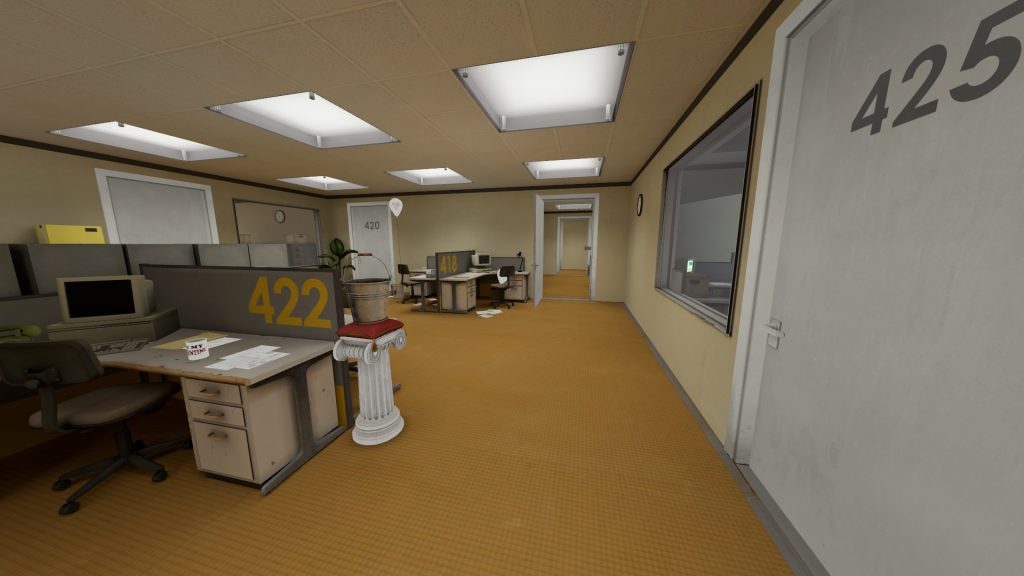
And then – something a bit less subtle, but still really good – the whole commentary on sequels came in. This was fun too, and touched on a lot of similar ideas. The jump circle, for instance, used as a method of giving players ‘what they really want’, and the other trope-y mechanics like the “Figleys” – pointless bonus content which otherwise adds no story element but instead exists to simply elongate game time – again questions the norms of what we are willing to accept (or perhaps should accept) in games.
The delivery of these themes was pitch perfect. Some disagree, saying this was really a way of the game hiding behind it’s own shadow in an attempt to avoid the same criticisms it was well aware of: simply being a sequel for the sake of being the sequel.
Well, that’s sort of the unavoidable point, and TSPUD is all too willing to embrace that fact. I don’t think they’re trying to make excuses (even if it is a little overplayed at times) – it’s a, great, healthy balance of tastefully tasteless, making us rethink our understandings of modern video game consumer culture.
This is the one thing you’d expect TSPUD to be good at, in fairness, being self-aware of its sequel-like status. But that doesn’t detract from the fact that Crows does deliver on this, and in a way that’s actually quite insightful, if all too blatant at times.
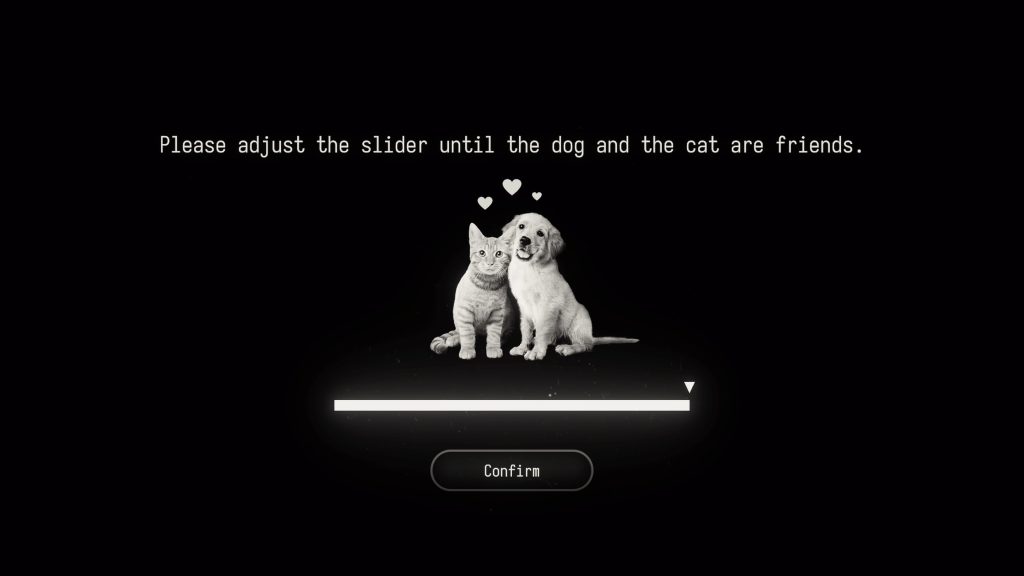
The New Narrator and New ‘Layers‘
I’m not really sure what to call them, but that text based narrator person who always asks me about the time whenever I boot up the game was quite a cool addition. The Stanley Parable is a game which is already in ‘limbo’ – it’s not clear who Stanley really is, where the narrator has come from, or how much control he really has over the game itself.
The new ‘layer of narrator’ in the form of this settings-guidance-person adds to that dynamic in quite a subtle way. It is now even less clear as to who holds control over the game. And that kind of confusion is the kind I like from The Stanley Parable; as many loose ends and unanswerable questions as possible, please.
It’s a Good Port!
And while the graphical changes are pretty minimal – a lot of Source games do tend to stand the test of time – the polish is pretty nice and the game is very well optimized. As far as ports from the Source engine to Unity go, this one is pretty impressive.
It plays the same, feels the same, the lighting is pretty nice as well. It means everyone can get a hold of the game easily, no matter what platform they’re on, and still get a good feel of that day one experience from 2013.
And I think, even though that has literally zero material benefit for players like myself, it is still very much worth crediting. It’s nice to see an iconic title released to the wider gaming world. And also it looked like it was quite hard to port over so faithfully, but I don’t port games so I have no idea about the level of effort which went into that. Bravo regardless.
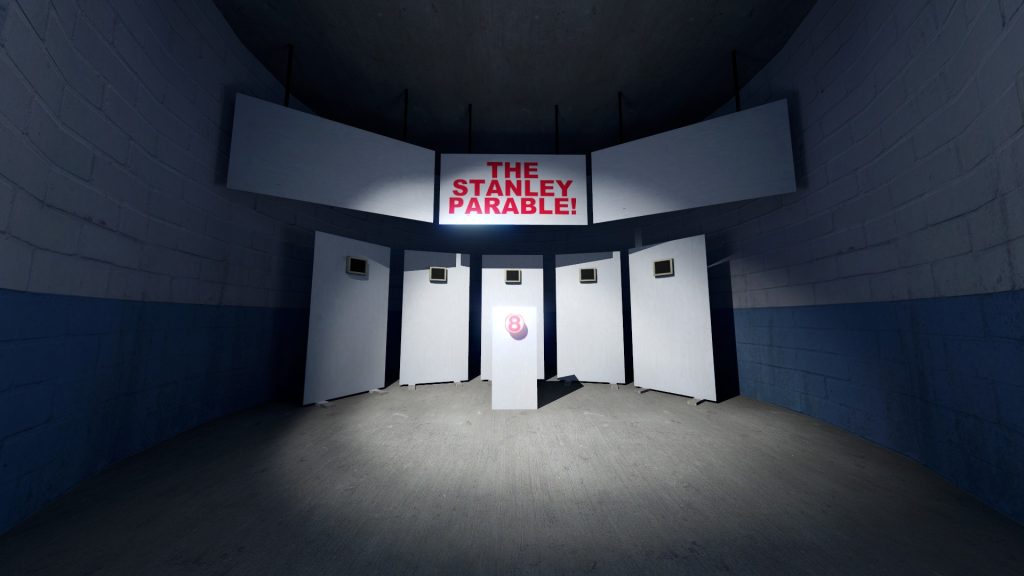
And what are the “cons”?
There’s Not Enough ‘Paths’
So here’s my main gripe with the new game: there’s not enough of it. There is, maybe at a push, 3 hours of new content. The way this game was marketed – especially as an “ultra deluxe” version – had me expecting quite a bit more than that.
At this stage, I would say we’re lacking the adequate data to poll on this properly, but if HowLongToBeat is any guide, then it’s even less generous than I am when compared to the time needed to beat the 2013 version.
Let’s look at the sequel marketing over the years for a moment. There’s probably more of a marketing effort than there is new game, to be honest. Not to say that the marketing is bad, or ineffective – quite the contrary, actually. But when one of the best extensions of your game isn’t even actually a proper part of the game…well, I don’t know. It’s telling.

In 2019, the game was delayed (as announced in a short ‘response’ video) on the premise that new content needed to be added to make this game as good as it could possibly be before release, and that the game would be a creative failure if it didn’t live up to such a standard.
Repeatedly after this, in the (genuinely pretty sparse) realm of ‘official’ video and newsletter updates (the Crows Twitter account has not stopped squawking since day one, mind you), the team has claimed that this new version will be a “significant expansion” of the original game with plenty of new things to do. I mean, the title alone should be more than enough proof that plenty of new content is on the way!
But, having played the game, I can’t help but feel a little bit deceived. There are 3 new distinct ‘paths’ in the game which I can identify. I should define what I mean by ‘path’ in this instance:
Path (noun)
A gameplay route that a player can travel through, behind which exists a distinct set of choices which may impact or create multiple endings to the game.
In a gameplay context: Some existing TSP paths included the right door, the left door, the cargo lift, the stairs to the bosses office, the blue door, etc.
For paths to be “distinct” they cannot exist in isolation, i.e I must have the choice of multiple branching routes at certain junctures of the game for them to be genuinely distinct paths.
So, distinct TSPUD paths? I can count three at a push, these being the “New Content” path, the Epilogue path and the Bucket path. One could make quite a valid case against including both the Epilogue and the Bucket path via the requirements of the aforementioned criteria, though, since:
1. The Epilogue is technically a further extension of the “New Content” path, even if it acts somewhat independently from it within the game;
2. The Bucket path is only distinct with regards to endings. It is not really at all distinct with regards to travel.

Some people may also argue that if you’re going to include the bucket path, then the Figley’s route counts as a new path – but it is literally just finding secret figures in the existing areas for a new ending, so I don’t count it, even when I’m being generous.
But regardless, the mere existence of this debate demonstrates the fact that the guarantee for plenty of genuinely “new content” in TSPUD is in contention. This is, again, not to say that the new content that is there is bad. It is very fun, entertaining, and engaging. But it’s just a bit too linear and a bit too repetitive.
An integral component of the original game was choice. The iconic image that everyone associates with it? It’s about choice. You’re told to make a choice, and different results come from said choice. But the new paths here have a pretty minimal amount of choice – unless you count the choice to bring a bucket with you everywhere you go as distinct. And, I guess, the choice of a new title each time you boot up the game post-epilogue.
Either way, these new choices lack any real meaning or weight. When I first picked the door on the right, I thought about the implications. The game even gave me the option to change my mind and get “back on track”. And even after I dismissed that, I was given more opportunities to obey and disobey the narration, making more choices for myself.
In the original TSP, I felt like someone else actually cared about my decisions, and that as such, I should also care about them, as they genuinely affect my outcomes and often reflect on certain elements of my personal character. However, I can’t say I feel this same weight when the only notable difference is this bucket I’m lugging around all over the place.

In these new paths, there are only a handful of instances where such choice is presented to you, and typically it does not modify the story in any meaningful way. The “New Content” route is incredibly linear, and does not allow for many detours. The multiple endings that result from it typically come from the restarts, meaning the only real choice I have is exactly when I decide to experience them, which is a choice I could have with literally anything else.
Like I said before, it’s about the journey. There’s enough destinations, sure. There’s plenty of new endings, I’m not going to deny that. But they all stem from identical journeys. Where are the new journeys? I loved discovering all sorts of strange scenarios and being allowed to play around with the Narrators’ wishes in new, strange environments.
Now I feel like he is simply lecturing me while I carry a bucket. The old paths are still there, but they’re not novel. The feeling of genuine discovery, and the reward that came with it – there’s not much more of it to go around in TSPUD.
I would list another subheading in the “Cons” section, but I actually don’t have anything else of substance to say. But this in and of itself is a con, because it again shows there isn’t enough new content to even criticize in the first place. It’s just a shame, since Crows has shown that they’re clearly very capable of adding something great to the story.
And the bucket endings are often good! I just don’t feel like I’ve really discovered anything by the end, or “earned” that ending by making the right choices. I’m just doing what I did before while carrying an inanimate object to earn a slightly different outcome. I feel like I had no real input into that. The bucket is the one leading me there, rather than the game forcing me to make decisions at critical junctures.

Maybe that’s the point. Maybe the bucket actually is the one in control…or, maybe if the bucket was the development lead, the bucket would have made more paths. It’s difficult to say.
Overall, you can kind of see why this is frustrating. On the one hand, we have a writing team that is clearly competent and able to make something great, while the art direction really encapsulates that original “feel” even after porting over to Unity. All the talent is there behind the scenes, meaning all the potential is ready to be realised.
It’s just…there’s not enough of it. And where there is something good, it’s done in a way that often feels derivative of some other gag. It’s the literal definition of “so close, yet so far”, and to be candid for a moment, it’s a tad upsetting for me.
The whole reason I loved the original Stanley Parable was for the exploration, for the suspense. Where would this lead me, what difference would this choice make? Where is the adventure line going? How long do I actually have to play the baby game for? Would this fern really matter in the end?

And there’s moments of that exploration that I love in the “new content”. But most of it isn’t even that new! It’s a reflection on the past, a meta commentary on itself – and this would be fine as far as new paths go IF it wasn’t the only really “new” path for us to experience.
It would be fine if it’s only rival wasn’t just a damned bucket and basically nothing else. The only suspense now often boils down to “what will this bucket ending look like?” or “I wonder what the new start screen will be?”. In terms of gameplay, for me, it just isn’t enough for a new standalone release.
ALL THAT SAID, HOWEVER. If you’ve never played TSP before, then 1: I’m surprised you’ve even read this far, and 2: this new version will still be very, very enjoyable for you. As far as first time experiences with a game go, this one is essentially superior to it’s original iteration when bringing newcomers into the franchise – especially given that it is now available on more platforms than ever before.
Crows has done a good job of facilitating this new fan base – but finishing this thing as someone who played the original, it feels like a punch in the stomach for the OG fans. You thought there’d be more than just expos and buckets? Too bad. Here’s a few new non-bucket endings scattered about, that’s all we’ll give you. Aside from that, feel free to play the game again and move on.
I think what I wanted was to feel that fuzzy-first-time-discovery-feeling I felt when I first played this thing nearly a decade ago. It’s a hard feeling to chase and a hard one to satisfy, I’ll give Crows that. But the great irony is I would have been satisfied with just a few more proper new branching paths, and I was more than willing to wait a little longer for them.
All I can hope for now is that The New Stanley Parable Super Massive Ultra Deluxe 4K UHD Prime Remix has something else to show in terms of paths. Or maybe we should just call it a day and do something else. Speaking of which, I’m going to write my dissertation now. Again, priorities. See you later.
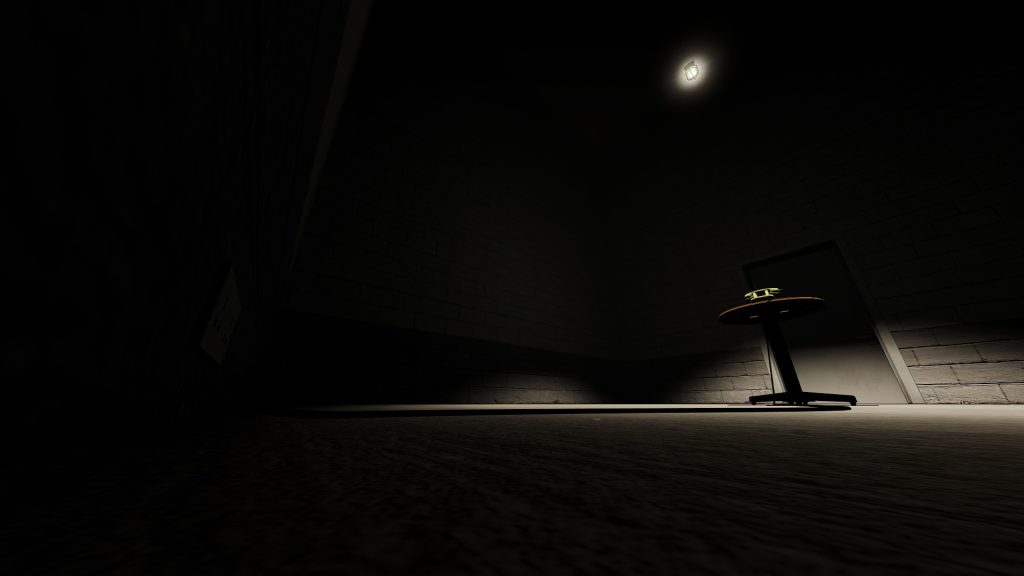


One reply on “the stanley parable ultra deluxe – an honest review”
Come from your TSPUD steam guide, keep up your great work my dude!